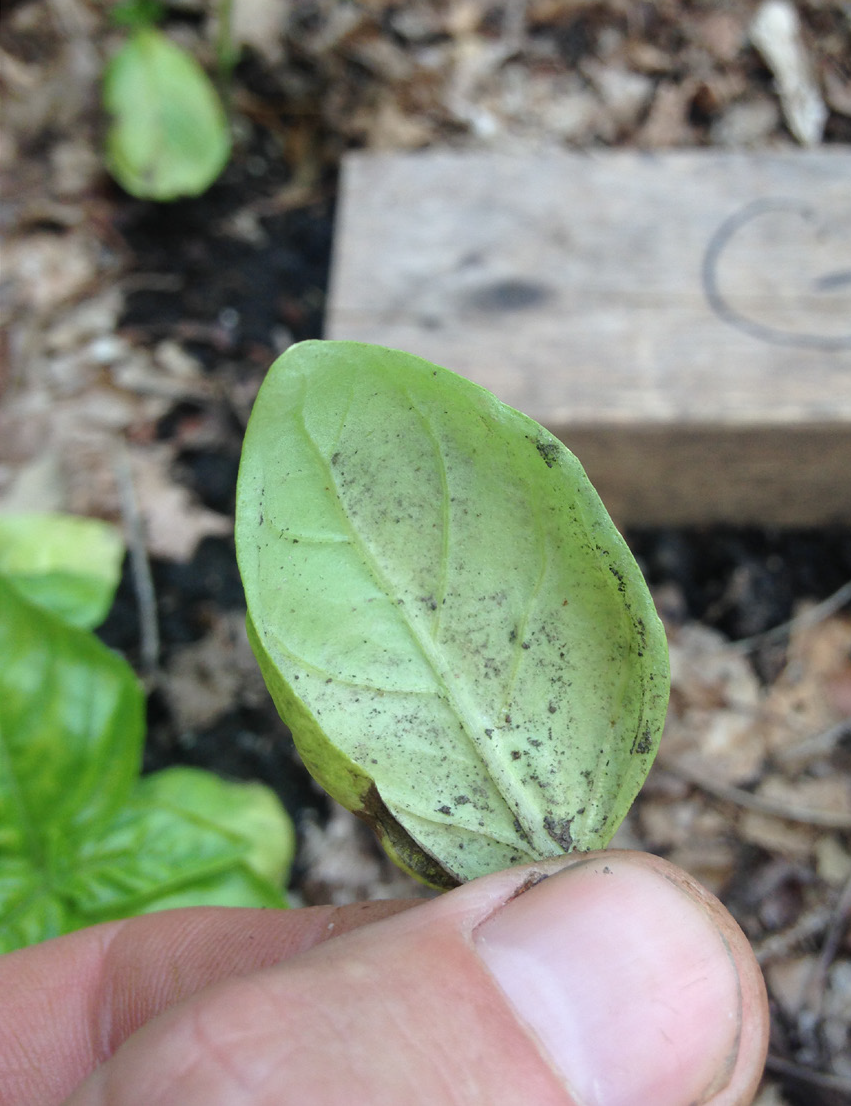This research was funded by Ceres Trust.
In a Nutshell:
- Carmen & Maja Black and Helaina Thompson, Mark Quee and Jon Yagla wanted to test new basil varieties bred for downy mildew resistance to see if they provided a longer harvest window and more produce than the traditional Genovese variety.
- They hypothesized that, the Prospera DMR and Rutgers Devotion DMR varieties would survive longer through the season and provide a more productive harvest period because they would not succumb to mortality caused by downy mildew.
Key Findings:
- Across all three farms, Prospera DMR yielded best among the three varieties tested. It was the variety least susceptible to mortality by downy mildew.
Background
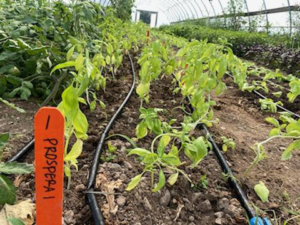
Prospera DMR in the greenhouse at the farm of Carmen & Maja Black and Helaina Thompson on Aug. 16, 2021.
Downy mildew is a disease that affects the leaves, stems, and branches in many plant species.[1] In the case of basil, downy mildew is caused by the fungal pathogen Peronospora belbahrii. The pathogen can be introduced to the basil through a contaminated seed, an infected transplant or by spores in the wind. Once Peronospora belbahrii is introduced into the basil crop it can spread rapidly through the wind and through contact between infected plants and healthy plants.[2] Downy mildew can completely decimate a basil crop. To try to reduce the amount of basil crops lost to downy mildew plant breeders have developed basil varieties for downy mildew resistance.[2]
The farmers in this project were interested in testing two new basil varieties, Prospera DMR and Rutgers Devotion DMR, both bred for downy mildew resistance (DMR), to see if they could provide a longer harvest window and more produce than the traditional Genovese variety. The cooperators hypothesized that compared to the traditional Genovese variety, the Prospera DMR and Rutgers Devotion DMR varieties will survive longer through the season and provide a more productive harvest period because they will not succumb to mortality caused by downy mildew.
Carmen Black said, “Though we successfully grow basil every year, I believe our customers would really appreciate a more consistent supply for a longer season as well as larger quantities per person. I hope that this project will allow us to hone in on and improve our basil production to a point where we are able to meet our growing number of CSA members’ basil needs.” Mark Quee was excited to “gain experience with several downy mildew resistant basil varieties. That should help me determine whether to go with a mix of several varieties (some not DM resistant, but cheap) or all in on DM resistant varieties.” Finally, Jon Yagla said, “Basil has been an unsuccessful crop for me. If these downy mildew resistant varieties actually work on my farm I will be able to grow basil again!”
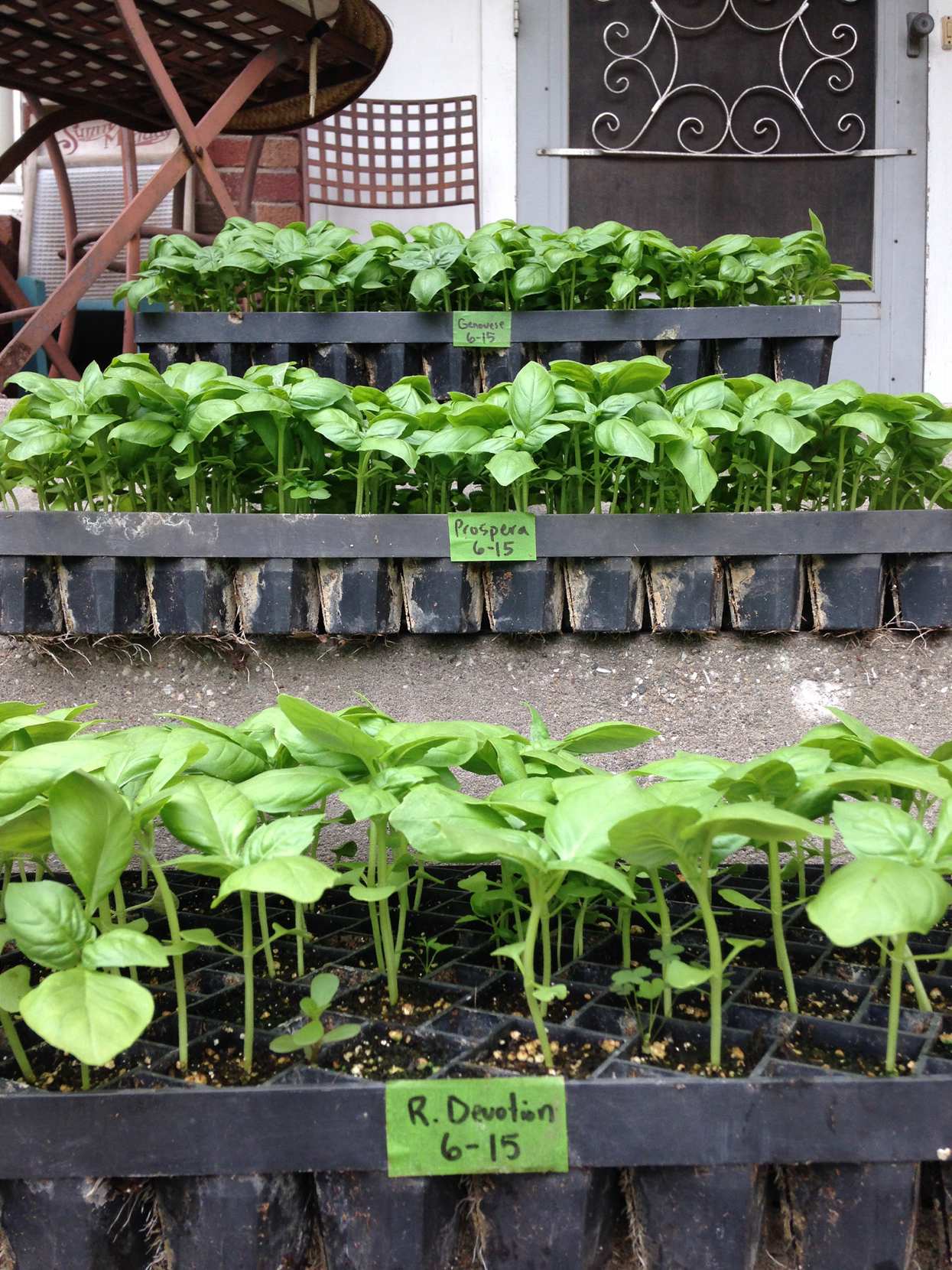
Basil varieties ready for transplanting at Jon Yagla’s on July 7, 2021. Seeds were started on June 15.
Methods
Design
Cooperators established four replication of three basil varieties in as many environments as they wanted. Varieties included: Prospera DMR, Rutgers Devotion DMR and Genovese. DMR refers to “downy mildew resistant” and Genovese was the control. The Blacks and Thompson decided to trial varieties in two environments: field and high tunnel. Both Quee and Yagla only trialed outside in the field. Each of these studies involved four replications of the three varieties (Figure A1). Management at each farm is detailed in Table 1.
Measurements
Each of the cooperators determined the yield of the basil for each of their varieties by collecting the plot weight of the basil each harvest date. While harvesting the cooperators also observed any downy mildew that they saw.
Data analysis
To rank the effect of variety on basil yield, we calculated Tukey’s least significant difference (LSD). If the difference in yield for any two varieties was greater than or equal to the LSD, we confirm that variety had a statistically significant effect on yield. On the other hand, if the difference in yield was less than the LSD, we consider the varieties to be statistically similar. We used a 95% confidence level to calculate the LSDs, which means that we would expect our rankings to occur 95 times out of 100. We could make these statistical calculations because the farmers’ experimental designs involved replication and randomization of their treatments (varieties) (Figure A1).
Results and Discussion
At Blacks’ and Thompson’s, they segregated basil leaves into three quality categories during harvest: firsts (highest quality); seconds (lower quality); bolted (leaves harvested from plants that had bolted). “I harvested good basil leaves off the plants that bolted, I just separated the bolt material from the edible leaves,” Thompson said. “The bolt separation process is a hassle but necessary, we think, for a nice-looking bundle, so it’s good to know if one of the varieties has less bolting.” For each quality category, Prospera DMR yielded best and did so in both environments (Table 2).
Downy mildew pressure was consistently least for Prospera DMR throughout the harvest periods in the field and in the high tunnel at Blacks’ and Thompson’s (Figure 1). By the Oct. 14 harvest date in both environments, Prospera DMR plants were the only ones still alive and producing marketable quality.
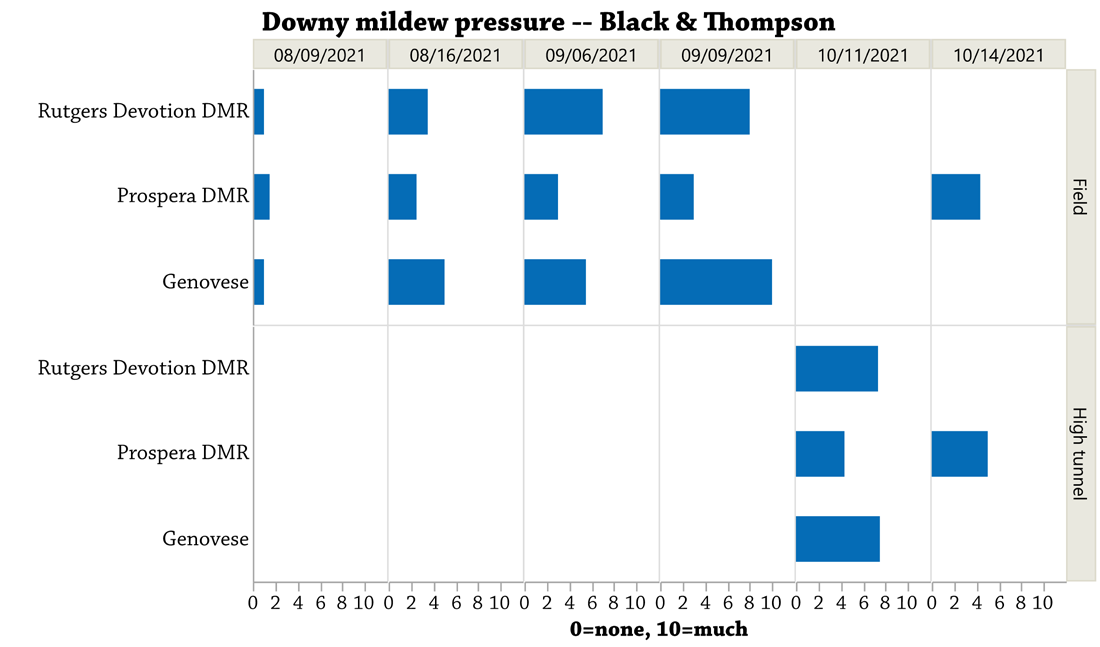
FIGURE 1. Downy mildew scores for each harvest date and in each environment at the Blacks’ and Thompson’s in 2021. These scores were not statistically analyzed.
“Prospera DMR was the only variety that survived the downy mildew attack of 2021,” Quee said of his trial. His results showed Prospera DMR was the clear winner in terms of yield over the course of the season (July 3–Oct. 12) (Figure 2).

FIGURE 2. Yield of all marketable basil for each variety at Mark Quee’s in 2021. Letters above bars indicate whether differences in yield were greater than the least significant difference (LSD = 2.9 lb/plot), indicating statistically significant differences at the 95% confidence level.
At Yagla’s, all Genovese plants succumbed to downy mildew and completely failed. “One Rutgers Devotion plant did not get downy mildew and I harvested it,” he said. All Prospera DMR plants survived through Yagla’s harvest window (Aug. 16–Sept. 28); it was the only variety to noticeably produce (Figure 3).
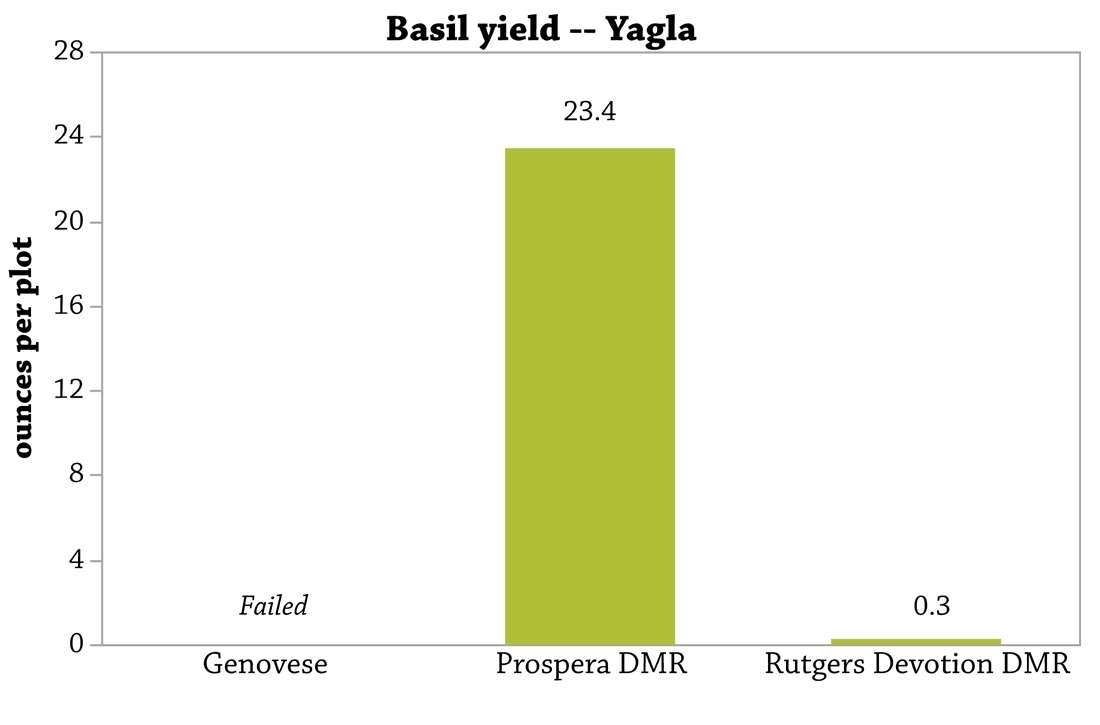
FIGURE 3. Yield of all marketable basil for each variety at Jon Yagla’s in 2021. Because all Genovese plots failed and only one Rutgers Devotion plant survived, we did not statistically analyze these results.
Conclusions and Next Steps
Across all three farms, Prospera DMR was the clear winner. It was the only variety of the three tested to survive throughout the course of each trial at each location. The other varieties (Genovese and Rutgers Devotion DMR) suffered far more downy-mildew pressure, which shortened the lifespans of the plants and ultimately reduced yield. “I now have a better understanding of which Italian basil variety to grow in my location for downy mildew resistance,” Yagla said. “It is great to have a basil variety (Prospera DMR) that will actually survive on the farm here in Iowa City!” Quee is likewise sold on Prospera DMR and will use it for the bulk of his basil production going forward. “We learned that disease resistant plant breeding can be successful, and (for now) what variety of basil we want to grow on our farm,” said Carmen Black about their plans for the future. For Helaina Thompson, the value of their results extend beyond this trial: “For me, the most valuable aspect of conducting this trial was learning about the downy mildew strains and plant breeding, and learning how to use that knowledge to make better decisions in the future– not just for basil.”
Appendix – Trial Design and Weather Conditions

FIGURE A1. Experimental design used by the farmers in the trial. This design allowed for statistical analysis of the results.
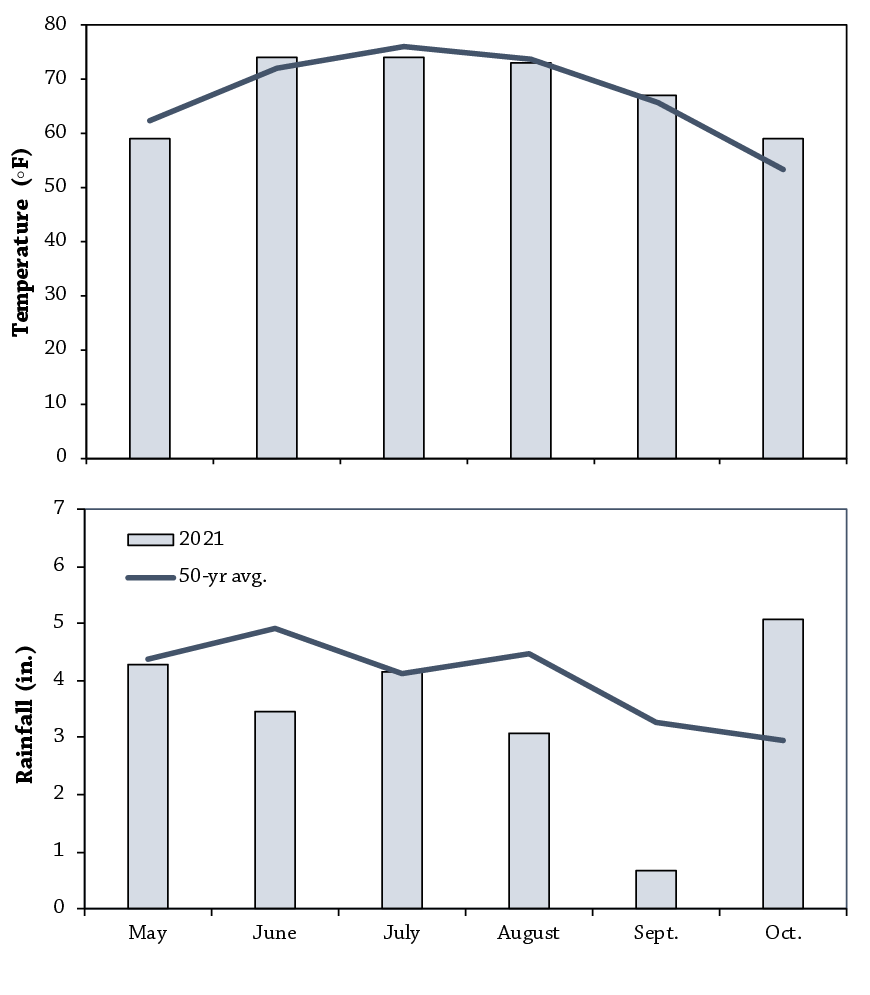
FIGURE A2. Mean monthly temperature and rainfall for 2021 and the long-term averages at Iowa City; the nearest weather station to all farms.[3]
References
- Dicklow, M.B. and A. Madeiras. 2018. Downy Mildews of Ornamental Plants. University of Massachusetts Amherst. https://ag.umass.edu/greenhouse-floriculture/fact-sheets/downy-mildews-of-ornamental-plants (accessed October 2021).
- McGrath, M.T. 2021. Basil Downy Mildew. Cornell University. https://www.vegetables.cornell.edu/pest-management/disease-factsheets/basil-downy-mildew/ (accessed October 2021).
- Iowa Environmental Mesonet. 2021. Climodat Reports. Iowa State University. http://mesonet.agron.iastate.edu/climodat/ (accessed October 2021).




